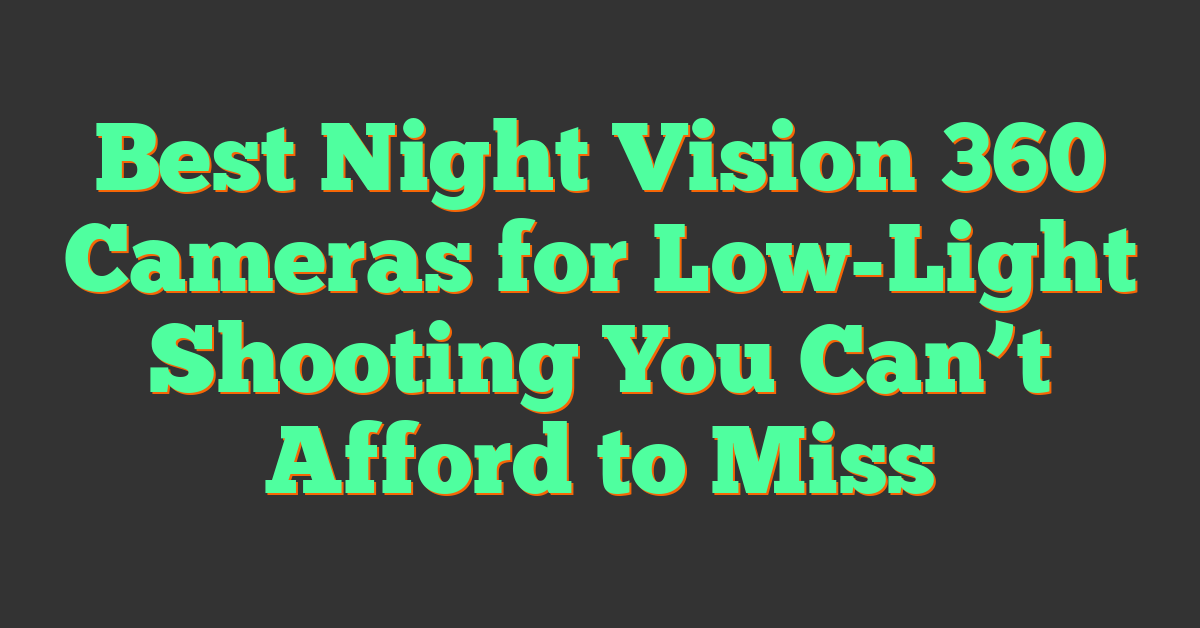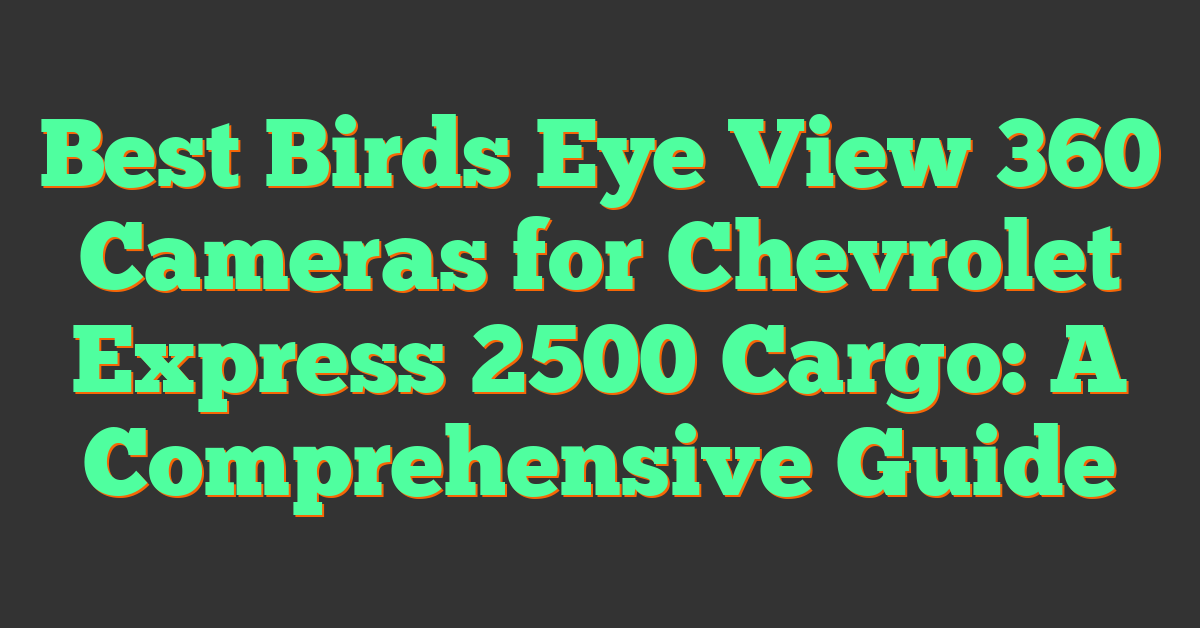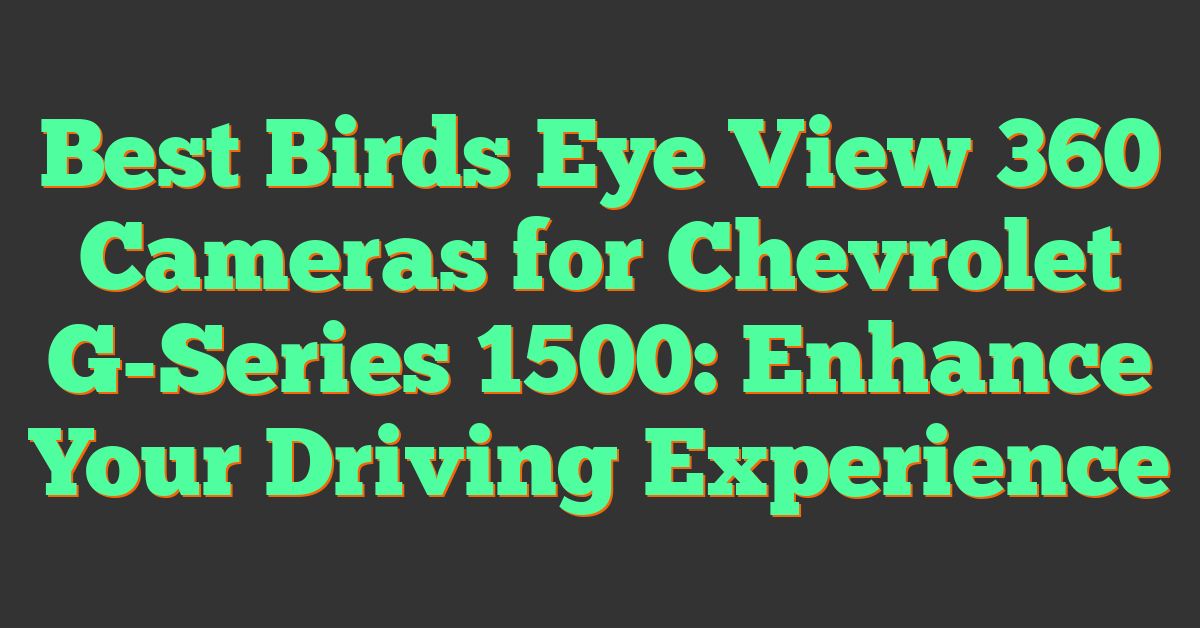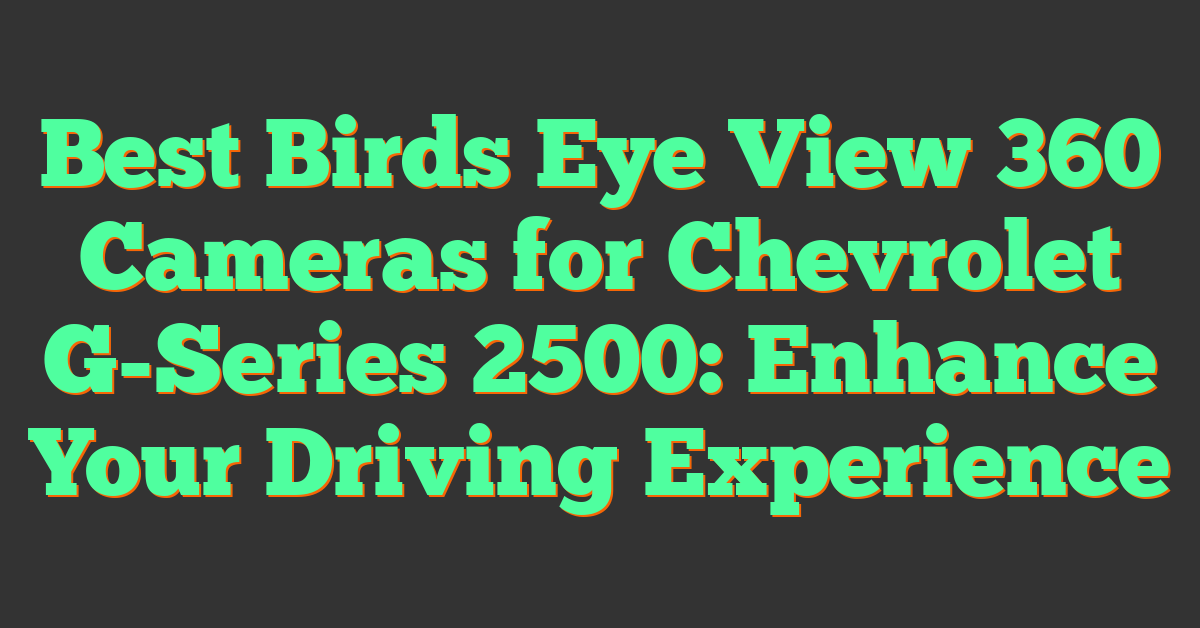Key Takeaways
- Night vision 360 cameras excel in capturing sharp, clear visuals in low-light or dark environments, making them ideal for security, outdoor adventures, and creative projects.
- Key features to look for include enhanced low-light performance, wide field of view (360°), high resolution (4K-8K), and battery life for extended usage.
- Advanced technologies like infrared (IR) illumination, large aperture lenses, and HDR capabilities significantly improve image and video quality in challenging lighting conditions.
- Durability and portability are crucial for varied scenarios, with options available for rugged outdoor use or lightweight travel-friendly designs.
- Budget options like the Ricoh Theta SC2 cater to casual users, while high-end models such as the Insta360 Pro 2 offer professional-grade performance.
- Proper camera settings, stabilization, and post-production editing enhance results when shooting in low-light conditions with night vision 360 cameras.
Capturing clear footage in low-light conditions can be a real challenge, especially when you need full 360-degree coverage. That’s where night vision 360 cameras come in, offering advanced features to ensure you never miss a detail, even in the darkest settings. Whether you’re shooting outdoor adventures, monitoring security, or working on creative projects, these cameras are game-changers.
With so many options on the market, finding the right one can feel overwhelming. I’ve rounded up the best night vision 360 cameras designed specifically for low-light shooting. From crystal-clear resolution to innovative night vision technology, these picks deliver exceptional performance when the lights go down.
What To Look For In Night Vision 360 Cameras
Choosing a night vision 360 camera requires careful attention to specific features that ensure optimal performance in low-light settings. From my experience with 360 cameras, these factors make a significant difference in achieving high-quality results.
Low-Light Performance
A camera’s low-light capability determines how well it performs in dark environments. Look for sensors designed for enhanced light sensitivity, such as back-illuminated sensors or large aperture lenses (f/1.8-f/2.0). Features like infrared (IR) illumination can also improve visibility, especially for night scenes or unlit areas. Cameras with advanced noise reduction, like multi-frame processing, reduce graininess and enhance clarity in poorly lit settings.
Field Of View
A wide field of view (FOV) ensures comprehensive coverage in 360 recordings, which is critical for immersive videos or virtual tours. Cameras offering at least 200° per lens provide excellent stitching for seamless 360-degree output. Multi-directional night vision adds an advantage by maintaining clarity throughout the entire scene, even in total darkness. Consider devices with optimized lens placement for minimal distortion at the edges.
Image And Video Quality
High resolution is essential for sharp visuals in low-light environments. Look for cameras that support at least 4K video and 12 MP still images, but 5.7K video and 18 MP or higher photos offer superior fidelity. Cameras using HDR (High Dynamic Range) technology retain detail in shadows and highlights, ensuring balanced exposure in uneven lighting. Devices equipped with high bitrates and professional codecs, like H.265, capture more data for cleaner results.
Battery Life And Durability
A durable camera is crucial for outdoor or extended shoots in challenging environments. Look for devices with rugged designs, water resistance (IP67 or higher), and built-in shock protection. Battery life is equally important; cameras with 1000-1500mAh capacity can last 1-3 hours of continuous recording, though external power options like USB-C ports add flexibility. Cold-weather performance is beneficial if you’re shooting in varying conditions.
Top Picks For The Best Night Vision 360 Cameras
I’ve curated this list of the best night vision 360 cameras to help you capture immersive, high-quality visuals even in the darkest environments. These options stand out for their performance, durability, and versatility.
Best Overall Night Vision 360 Camera
Insta360 ONE RS 1-Inch 360 Edition
This camera is my top pick for its exceptional low-light performance and versatile design. Dual 1-inch CMOS sensors deliver impressive low-light footage with enhanced clarity and minimal noise. It supports 6K video resolution, ensuring sharp, immersive content even in dark conditions. With built-in FlowState stabilization, footage stays smooth even during movement.
« The Science Behind 360-Degree Photography: How It Works and Why It’s Transforming Visual Media
How 360 Cameras Improve Visual Documentation and Revolutionize Content Creation »
The modular setup is ideal for photographers and videographers who need flexibility. Its durable build and waterproof housing make it suitable for various environments.
Best Budget-Friendly Option
Ricoh Theta SC2
Though more affordable, the Theta SC2 doesn’t compromise on night vision features. A Night View mode enhances exposure and reduces graininess, making it a solid choice for those on a budget. This compact 360 camera captures 4K video and detailed stills with realistic colors.
Its simple interface is beginner-friendly, and the lightweight design is easy to carry, whether you’re using it for personal projects or casual low-light outings.
Best High-Resolution Night Vision Camera
Insta360 Pro 2
For maximum detail, the Insta360 Pro 2 excels with 8K video resolution. Six high-quality lenses and advanced low-light sensors make it perfect for professional-grade night vision projects. With proprietary HDR video capability, the camera manages dynamic lighting seamlessly, making scenes look natural even with varying levels of darkness.
Its robust design pairs well with long battery life, making it suitable for extended shooting sessions. Features like in-camera stitching enhance workflow efficiency for both photographers and videographers.
Best Compact And Lightweight Design
Kandao QooCam 8K
The QooCam 8K combines high performance with portability. Its 1/1.7-inch sensor is optimized for low-light settings, capturing clear 8K videos and 30MP stills despite its compact size. A built-in touchscreen simplifies control adjustments without relying on external devices.
It’s lightweight and easy to carry, making it ideal for travel, urban exploration, or quick low-light captures. USB-C fast charging adds convenience, so you can keep shooting with minimal interruptions.
Comparison Of Features And Specifications
Examining features and specifications is critical when assessing night vision 360 cameras. I’ve analyzed the top models mentioned earlier to provide a side-by-side comparison, focusing on resolution, low-light technology, field of view, battery life, and portability.
| Model | Resolution | Low-Light Tech | Field of View (FOV) | Battery Life | Weight |
|---|---|---|---|---|---|
| Insta360 ONE RS 1-Inch | 6K | 1-Inch Sensor + IR Lens | 360° | 75 minutes | 239g |
| Ricoh Theta SC2 | 4K | Night View Mode | 360° | 60 minutes | 132g |
| Insta360 Pro 2 | 8K | Advanced HDR + Night Shot | 360° | 50 minutes (detached battery available) | 1550g |
| Kandao QooCam 8K | 8K | Effective HDR Processing | 360° | 70 minutes | 435g |
Resolution
Higher resolution delivers sharper and more immersive visuals. The Insta360 Pro 2 and Kandao QooCam 8K offer 8K output for professional-level detail, while the Insta360 ONE RS strikes a balance with 6K.
Low-Light Technology
The Insta360 ONE RS integrates a 1-inch sensor with infrared (IR) capability, amplifying low-light sensitivity. The Ricoh Theta SC2 provides a Night View mode tailored for basic low-light shooting. The Insta360 Pro 2 and Kandao models leverage advanced HDR for optimal brightness balance.
Field of View (FOV)
All cameras maintain a full 360° field of view, ensuring comprehensive scene coverage. This is essential for immersive media creators or security personnel needing broad area visualization.
Battery Life
For longer shoots, battery performance varies. While the Insta360 ONE RS offers moderate longevity at 75 minutes, models like the Ricoh Theta SC2 suit shorter sessions. The Insta360 Pro 2, though limited with its built-in power, supports a modular battery swap for uninterrupted use.
Portability
Weight directly affects portability. Travel photographers often prefer lightweight options, like the Ricoh Theta SC2 and Insta360 ONE RS, while studio usage or stationary tasks align better with heavier systems like the Insta360 Pro 2.
Pros And Cons Of Night Vision 360 Cameras
Pros
- Enhanced Low-Light Recording
Night vision 360 cameras excel in capturing clear visuals in dark environments. Advanced infrared sensors and light-sensitive technology allow for detailed imaging even in near-total darkness, which is invaluable for night photography, security footage, or creative filmmaking.
- Full 360° Coverage
These cameras deliver comprehensive coverage, eliminating blind spots. This feature is crucial for immersive virtual reality projects or monitoring large areas, offering greater situational awareness than standard cameras.
- Versatility Across Use Cases
From professional videography to personal travel vlogging, these cameras adapt to multiple scenarios. Night vision capabilities expand their usability for nighttime outdoor adventures, wildlife observations, or low-light event documentation.
- Improved Resolution in Darkness
High-quality models like the Insta360 Pro 2 provide ultra-high resolution, such as 8K, ensuring sharp detail even in challenging lighting. This level of clarity enhances the viewer’s experience and aids post-production editing.
Cons
- Higher Cost for Advanced Models
Premium features such as 8K resolution, infrared capabilities, and enhanced sensors contribute to the higher price point of top-tier models. Budget options may lack these advanced night vision technologies.
- Battery Drain in Night Mode
Activating infrared or specialized night vision modes consumes more power, reducing battery life. For instance, while the Insta360 ONE RS performs well, its 75-minute duration might require backup batteries for extended shoots.
- Increased Weight in High-End Units
Advanced night vision systems often come with bulkier hardware. Devices like the Insta360 Pro 2 are heavier due to their multiple sensors and modules, which may impact portability and ease of use during long sessions.
- Complex Post-Production Workflow
Editing 360-night vision footage demands familiarity with software tools and workflows. Retaining image brightness and reducing noise in dark conditions requires additional time and expertise in post-production.
Tips For Using Night Vision Cameras In Low-Light Conditions
Adjust Camera Settings
I recommend manually adjusting settings like ISO, aperture, and shutter speed to improve performance in low light. Increasing ISO helps capture more light but can introduce noise if set too high. A wider aperture (low f-number) allows more light to reach the sensor, which is useful for darker environments. Slower shutter speeds let in more light but require stability to avoid motion blur.
Use External Lighting
Even with night vision capability, adding external infrared lights enhances visibility in extreme darkness. Many night vision 360 cameras work well with infrared illuminators, which provide additional light without visible disruption. Position the lighting carefully to avoid glare or uneven brightness in your footage.
Stabilize the Camera
Tripods or gimbal stabilizers minimize vibration, ensuring smoother footage in low light. Night shooting often involves longer exposure times, where stability becomes critical to maintaining high-quality results. Look for a lightweight yet stable setup to suit your camera’s portability.
Plan Before Shooting
Scouting the location beforehand ensures better control over obstacles and lighting sources. Evaluate potential hotspots or reflective surfaces that may interfere with the infrared signal. Pre-planning also helps you determine the right settings and accessories needed for optimal results.
Keep Lenses Clean
Dirt or fingerprints on the lens reduce clarity, especially when shooting in low light. Use a microfiber cloth and keep a lens cleaning kit handy during nighttime shoots. Regular maintenance ensures the infrared capabilities of the camera aren’t compromised.
Optimize Battery Usage
Night vision modes drain batteries faster due to infrared operation and higher sensor activity. Carry spare batteries or power banks, particularly for models like the Insta360 Pro 2, which support modular swaps. Managing usage time avoids interruptions during extended shoots.
Experiment With Angles
Test various elevations and perspectives to maximize the 360° capabilities of your device. Low-light environments benefit from unique viewpoints, capturing immersive footage while balancing light and shadows. Experimentation often reveals the most cinematic angles.
Post-Process Wisely
Editing tools like Adobe Premiere Pro or Insta360 Studio enhance low-light footage by reducing noise and adjusting exposure. Applying gentle de-noising and contrast improvements refines the details captured during nighttime, resulting in cleaner visuals. Avoid over-editing that might distort natural elements.
Conclusion
Choosing the right night vision 360 camera can make a world of difference when shooting in low-light environments. With so many advanced options available, it’s easier than ever to capture sharp, immersive footage even in challenging conditions. By considering factors like resolution, low-light technology, battery life, and portability, you can find a camera that fits your needs and budget.
Whether you’re capturing outdoor adventures, enhancing security, or working on creative projects, investing in a high-quality night vision 360 camera ensures you won’t miss any detail in the dark. Take the time to explore your options, experiment with settings, and make the most of these innovative tools to elevate your low-light shooting experience.















